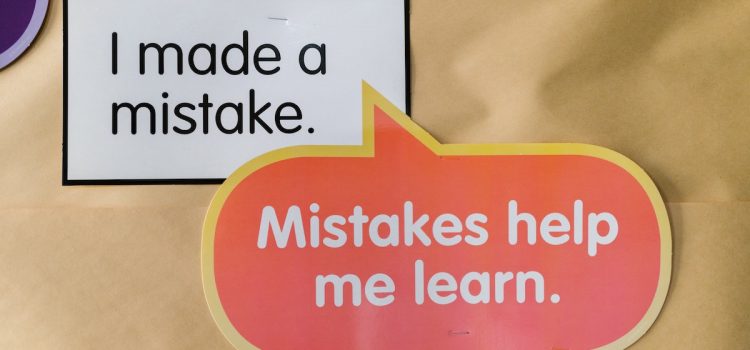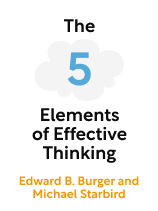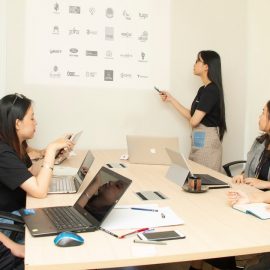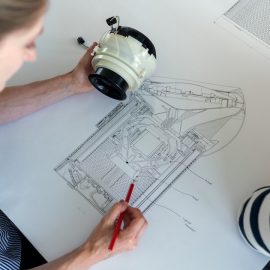

This article is an excerpt from the Shortform book guide to "The 5 Elements of Effective Thinking" by Edward B. Burger and Michael Starbird. Shortform has the world's best summaries and analyses of books you should be reading.
Like this article? Sign up for a free trial here.
Do you ever make mistakes on purpose? If you do, what do you learn? What if your mistake is a solution to another problem?
When you fail at solving a problem, you can set yourself up for success next time if you analyze why you failed and think about what you can do to prevent failure in the future. Specifically, you can make intentional mistakes, and you can investigate where your mistake might be a different problem’s solution.
Read more to find out how to learn from mistakes.
How to Learn From Mistakes
In The 5 Elements of Effective Thinking, Edward B. Burger and Michael Starbird discuss how to learn from mistakes in the context of the element of fire, which they say represents embracing failure as a learning tool. Once you’ve established a firm foundation of knowledge, you can begin expanding that knowledge by learning from failure, and in doing so, advancing your thinking through trial and error.
- Make mistakes on purpose
- Extend the lessons from your mistakes beyond your current problem
(Shortform note: The concept of learning by failing aligns with the theory of trial and error learning outlined in 1913 by Edward Lee Thorndike, who suggested that all learning occurs when the learner makes mistake after mistake until they finally hit on the right solution. Thorndike’s theory implies a randomness to the process, contrasting with Burger and Starbird’s theories, which emphasize that you should reflect on your failures in order to direct your next attempt.)
Technique #1: Make Mistakes on Purpose
Sometimes you’ll find yourself progressing quickly with few noticeable mistakes. The authors advise that, when that happens, you should seek out mistakes to create your own learning experiences. They point out that companies will do stress tests on their products, looking for what it takes to break what they’ve made. Apply this to your own thinking. Ask yourself: “What would it take to disprove this idea? What flaws can I expose in my understanding?”
(Shortform note: Studies have shown that our own expertise can work against us if we become too fixed on it. If we have found a way of doing something that works, we often have a hard time letting go of that, even if we run into a situation where a different method would work better than the one we’re familiar with. Feeling like we already know how to do something makes us less likely to see other, potentially better solutions. Experts recommend taking on a “beginner’s mindset,” from the Buddhist concept of shoshin. Approaching a topic as if we have no expertise, even if we have plenty, can give us greater insights than if we relied on our preconceived understanding.)
The authors suggest some techniques that can help you create your own mistakes and learning experiences:
1. Make bad leaps in logic or unfeasible goals. Consider what you would do if you had no limits on what you could do, and see if that leads you to a more immediate insight. For example, a Spanish teacher might imagine that with no restraints, they might take their students to Spain, Mexico, or another Spanish-speaking country to immerse their students in the language. That’s not something most public school teachers can accomplish, but it might lead to the idea of taking the students to a local business run by native Spanish speakers and letting the students practice that way.
(Shortform note: In The 10X Rule, Grant Cardone agrees that you should set overly ambitious goals, suggesting that small goals are often not exciting enough to motivate a person to work hard to achieve them. He advises setting goals that are 10 times greater than the standard and then working 10 times harder to reach those goals.)
2. Make a wild exaggeration of your idea. Does this exaggeration reflect any of the same issues that your original problem poses? For example, say you run a company that produces trampolines. Your products are made for humans, but just for fun, imagine that an elephant uses one. What happens to the trampoline? Could that happen if a human were to use it? Does the exaggeration reveal a specific structural flaw that could be fixed to make the product better overall?
(Shortform note: While making mistakes can be educational, keep in mind that you should avoid practicing that mistake, particularly when it comes to performing tasks or skills. If you’re learning a new song on the piano and you hit a wrong note in bar 14, you can learn from that mistake, but the next time you play the song you should be able to play bar 14 correctly. If you note the mistake but just continue playing, you’re not learning from the mistake, you’re learning to make the mistake every time you do it.)
Technique #2: Look Beyond Your Current Problem
The authors note that, even when a mistake reveals no insight into your current problem, it can still be useful; it might be the solution to a completely different problem than the one at hand. Ask yourself: “Did my mistakes present any insight into other problems separate from the one I’m focusing on?”
They give an example of an employee at 3M who was trying to create a very strong adhesive but ended up creating one so weak that it could be removed from an object without even peeling off the adhesive. A complete failure with regard to his goal at the time. But later, when another scientist at the company was trying to figure out a way to mark pages in a book without causing any damage, this adhesive turned out to be the perfect thing to apply to a small slip of paper, resulting in the invention of the Post-it note. Had they scrapped the original idea entirely and never revisited it, they would have lost out on a product that is now so popular you can find it in almost any office.
| Thinking Differently One way to cultivate the ability to look past your current problem and see if your solution may have greater or other applications could be to purposefully change your mind’s focus. In A Mind For Numbers, Barbara Oakley describes two types of “modes” in which the brain functions. “Focused mode” is when your brain is actively concentrating on a specific thing, whereas “diffuse mode” is when your brain is not actively concentrating and is instead allowed to wander. If you’ve come up with a potential solution for a problem while in focused mode, but the solution proves ineffective, allowing your mind to enter diffuse mode may lead you to see applications for that solution beyond what you were previously focused on. Other experts have conceived of these modes in other ways. In Hyperfocus, Chris Bailey characterizes them as “hyperfocus” and “scatterfocus.” He suggests that hyperfocus is the ideal mode for productivity, while scatterfocus is ideal for creativity. In the case of the Post-it note example, the employee who first came up with the adhesive was likely in focused or hyperfocus mode, actively trying to produce a product to solve a specific problem. However, the employee who later thought to use this adhesive to create the Post-it note took this already-existing idea and came up with a creative application for it beyond its original intended purpose. This reflects diffuse or scatterfocus mode. Both of these theories draw from neuroscience, with the concepts of “diffuse mode” and “scatterfocus” relating to the engagement of the brain’s default network. This network is made up of specific portions of the brain that are more active when the brain is not actively focused on any idea or task. |

———End of Preview———
Like what you just read? Read the rest of the world's best book summary and analysis of Edward B. Burger and Michael Starbird's "The 5 Elements of Effective Thinking" at Shortform.
Here's what you'll find in our full The 5 Elements of Effective Thinking summary:
- The 5 principles for learning to think effectively
- What it means to learn beyond memorizing
- Why you need to be willing to change if you want to learn






